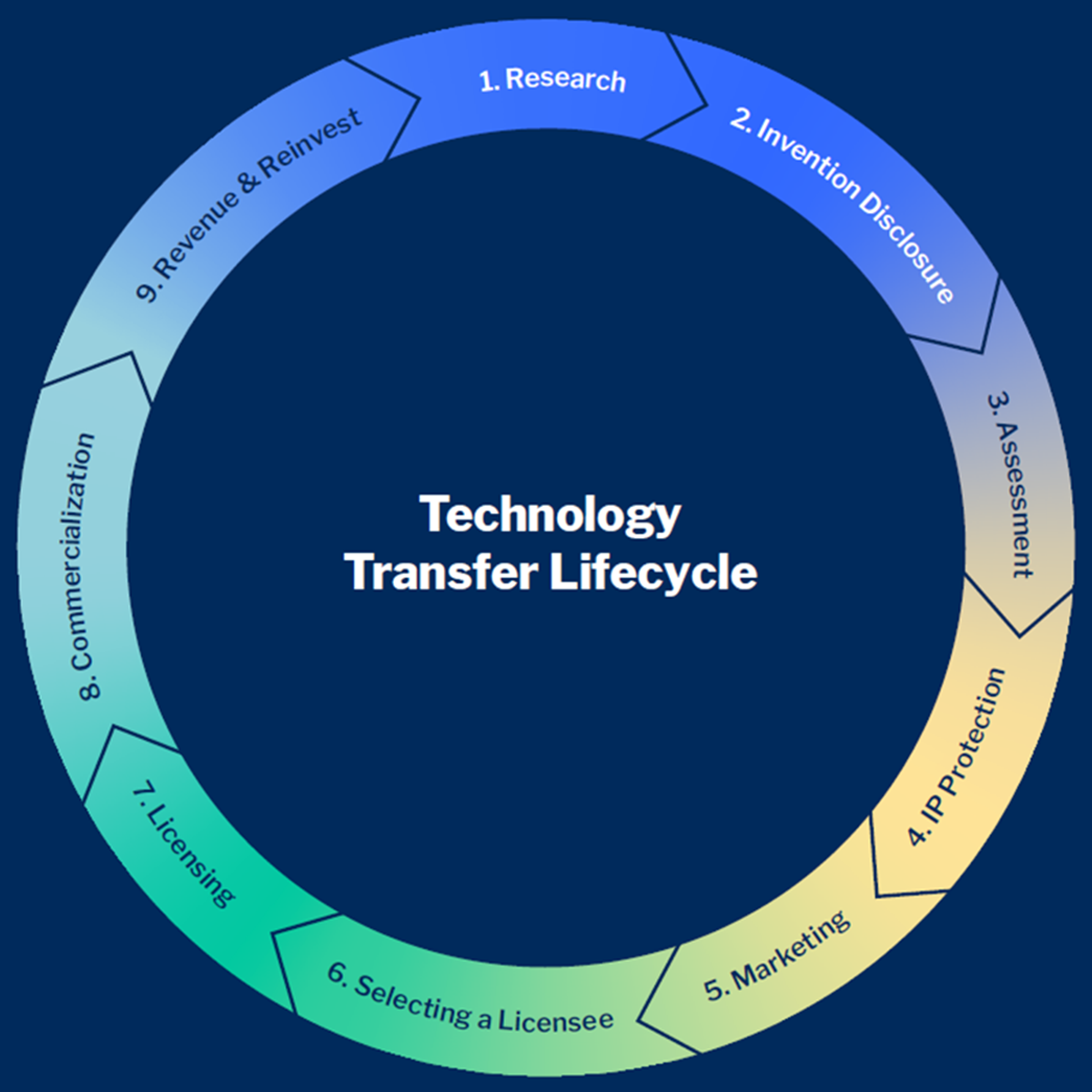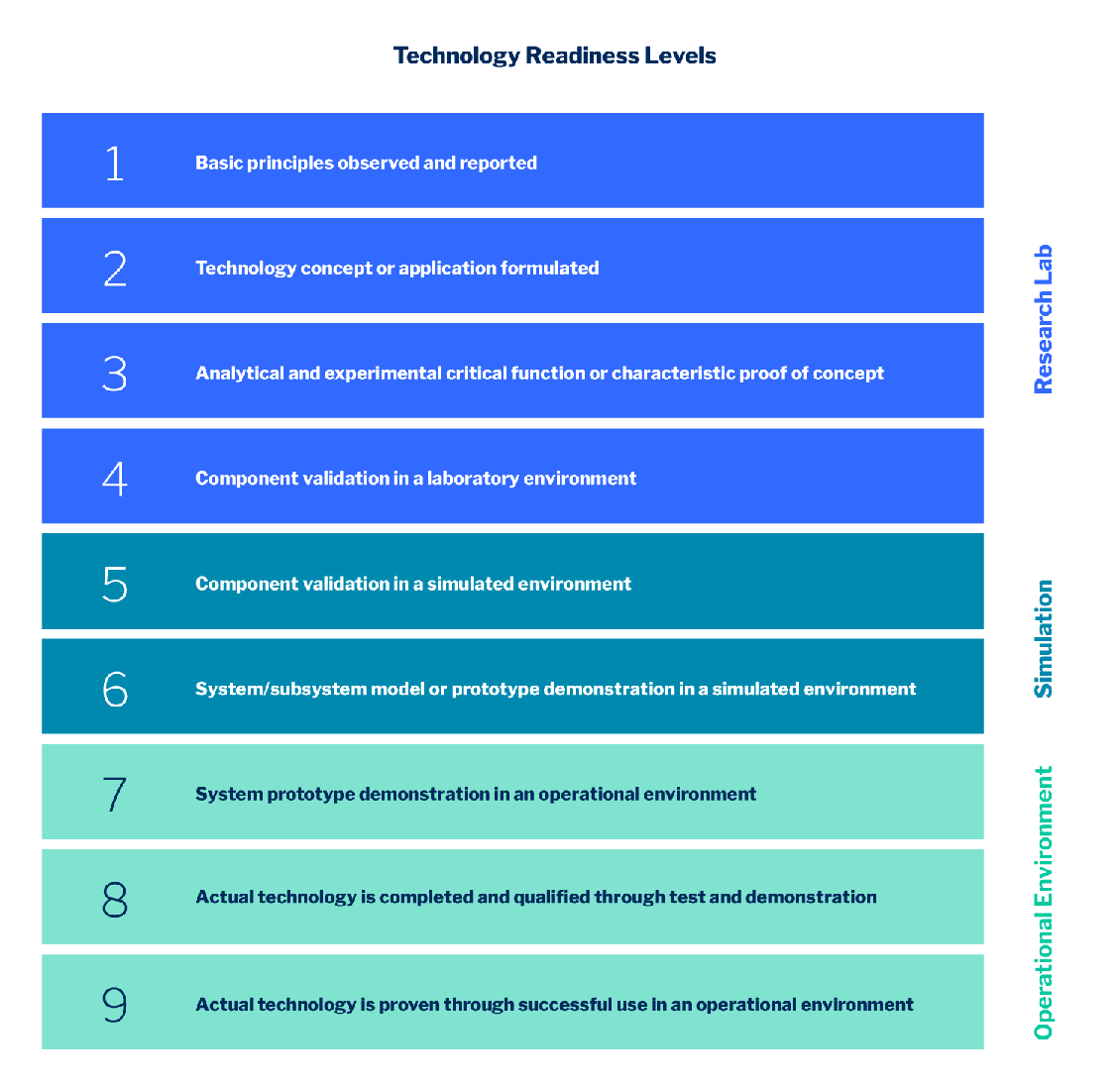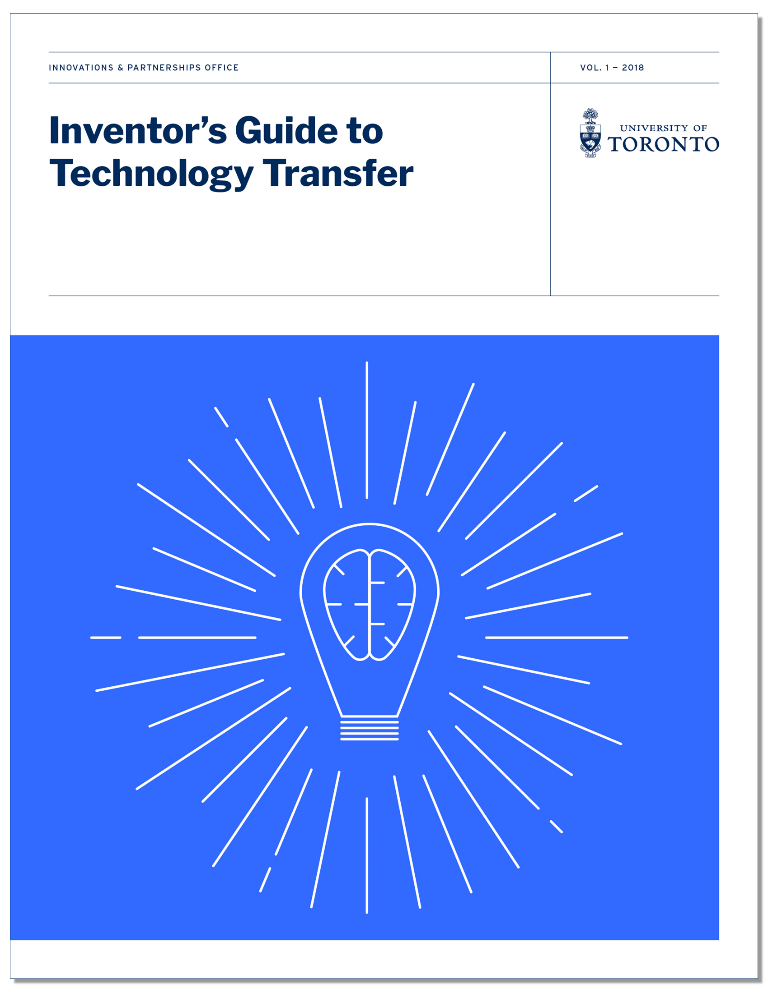Commercialization and technology transfer are the activities that turn university knowledge into marketable products or processes that create social and economic value.
The Innovations & Partnerships Office (IPO) is your first stop for commercialization at U of T. IPO manages U of T’s portfolio of intellectual property (IP) and helps build successful relationships between industry, government, and the U of T research community. IPO’s expertise in licensing, start-up creation, business development, and legal help turn U of T innovations into products, services, companies, and jobs.
For a broad view of commercialization at U of T, please read about U of T’s Commercialization Framework and associated Commercialization Plan.

Technology transfer a continuous cycle where research drives innovation toward the creation of commercial products and services, which in turn help fund future research and innovation.
1. Research
Observations and experiments can lead to new discoveries and inventions. An invention is any new process, machine, composition of matter, or useful improvement thereof. Under the U of T Inventions Policy, such things as research tools, computer software, data sets and the related know-how associated with them are also considered inventions.
2. Invention Disclosure and Assignment
U of T has a modern, flexible invention ownership policy that is ‘Inventor’s Choice’: If U of T resources (e.g. facilities, equipment, or funding administered by the University) were used in the creation or development of the invention, U of T’s Inventions Policy applies.
At the time of creation, inventions are co-owned by the inventor and the University (‘joint ownership’). An exception to joint ownership is if the rights to an invention were granted to a third party under a prior agreement, such as a grant, sponsored research agreement, or material transfer agreement.
A written Invention Disclosure to IPO defines the invention, inventors, funding sources and other related agreements so ownership and rights to the invention can be determined. U of T inventors have the obligation to disclose their inventions to the University, is a requirement before selling, licensing, or otherwise assigning the invention. This also applies to some copyright material. For more information on copyright please see the Copyright Policy.
Once an invention is disclosed, inventors may choose to assume full ownership and responsibility for patenting and commercialization (‘Inventor-owned’) or they can offer to assign the invention to U of T (‘University-owned’). When the University accepts assignment, following an intellectual property (IP) and market review, IPO is responsible for managing patent expenses and associated licensing revenues. IPO will also work with inventors to determine a commercial path for the technology. Preferably, a patent should not be filed until ownership is determined.
Inventors are able to publish and present the results of their research and still protect the commercial value of their IP, however, patent rights may be affected by these activities. It is best to submit an Invention Disclosure before communicating about the invention publicly. There are significant differences between Canada, the U.S., and other countries as to how publication affects a future patent. Be sure to inform IPO via the contact listed below of any imminent or prior public disclosure if you are considering a patent application.
3. Assessment
If the inventor requests to assign the invention to U of T, IPO evaluates its commercialization, marketing, and intellectual property potential.
Key considerations for determining commercialization potential include the following.
- What is the problem the invention solves or improves upon?
- What are the top alternative ways to solve the problem? Is the invention faster/cheaper/better?
- What is the stage of development of the Invention? The development stage is often referred to as the Technology Readiness Level (TRL). Image 2 depicts the different levels. More details about the nine levels can be found at Innovative Solutions Canada: Technology Readiness Levels
- Is the team willing to improve the technology readiness?
- What are all the possible applications of or markets for the invention? How big is the market?
- Are there any ready receptors or partners for the technology?

If Inventors choose to take personal ownership, IPO does not assess the invention, nor complete steps 4-9 below. Please see Guidelines for Personal Ownership of Inventions for more information on this option.
4. Intellectual Property Protection
According to the World Intellectual Property Office (WIPO), “Intellectual property (IP) refers to creations of the mind, such as inventions, literary and artistic works, designs, and symbols, names and images used in commerce.” IP is protected in law by patents, copyright, and trademarks, which enable recognition or financial benefit from creations. Unique biological materials and software can also be licensed without formal IP protection (e.g. through Material Transfer Agreements or Open Source Licenses).
Patent rights may be affected by public disclosure (e.g. written publication or presentation), so it is best to involve IPO early.
Learn more about protecting intellectual property.
5. Marketing
With support from inventors, IPO specialists evaluate and define the market opportunity for U of T inventions. This step involves identifying potential customers and competitors, and the key expertise, resources and business networks needed to bring the technology to market. During this stage the technology is promoted directly to potential customers, through our website, and other marketing platforms such as In-Part. Through this process the optimal path to market is outlined, which may include creating a start-up or licensing to an existing company.
6. Selecting a Licensee
When appropriate licensees are engaged, IPO licensing specialists work to develop the financial and diligence terms to fully commercialize the technology. Licensees, if appropriate, will be asked to follow global access principles and startup venture licensing guidelines.
7. Licensing
IPO works with the licensee to negotiate and execute an option, license, or assignment agreement. These agreements give the licensee(s) rights to a technology in return for commercially reasonable financial benefits.
8. Commercialization
The licensee continues the advancement of the technology and makes other business investments to develop the product or service. This step may entail further development, regulatory approvals, sales and marketing support, training, and other activities.
9. Revenue
Any invention revenues received by U of T are distributed annually to inventors, departments, units, and the Connaught Fund as per the U of T’s Inventions Policy.
For Inventor-owned technology, net revenues from license fees, royalties, and/or equity are shared 75%/25% between the inventor(s) and the University. For University-owned technology, net revenues from license fees, royalties, and/or equity are shared 60%/40% between the inventor(s) and the University. In both cases, the University share of proceeds supports faculties and departments, covers costs and advances the University’s academic and research mission.
Learn more about U of T’s Inventions Policy and revenue sharing.
IPO has created a guide that provides more detail on the commercialization and tech transfer process at U of T. This handbook contains more information on disclosing and protecting an invention, FAQs from our research community, and other services available for U of T inventors.
Contents:
- Overview
- The Technology Transfer Process
- Ownership of Intellectual Property
- Research Considerations
- Invention and Technology Disclosures
- Assessment of an Invention Disclosure
- Patents
- Other Intellectual Property
- Marketing an Invention
- Licenses and Other Agreements
- Commercialization
- Revenue Distributions
- Start-Up Companies
- Navigating Conflict of Interest
- Appendix: IPO Innovation Team Contacts
- Advise on U of T’s Inventions Policy
- Receive and evaluate invention disclosures for technologies created by U of T faculty, staff and students
- Support the protection of U of T IP through patenting and other means
- Assist in finding partners and funding to support proof-of-concept and commercialization
- Market U of T technologies to industry
- Negotiate license agreements with interested companies
- Support long-term relationships with strategic partners that help develop early-stage discoveries into market-ready technologies and products





